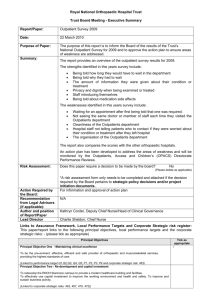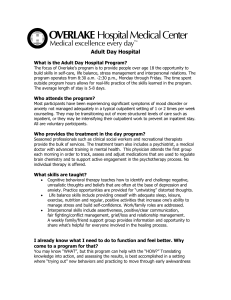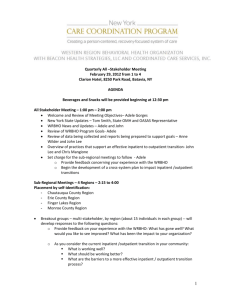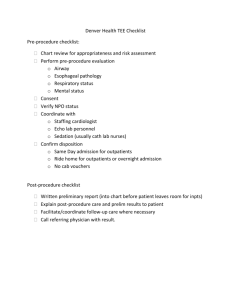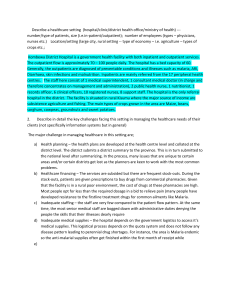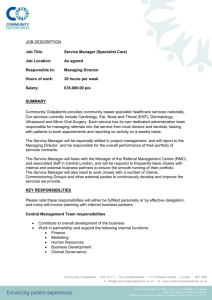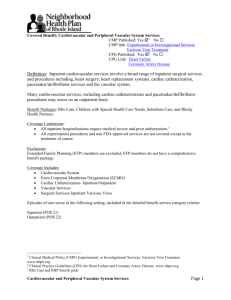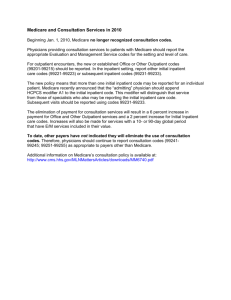Data Sources and Clinical Coding
advertisement
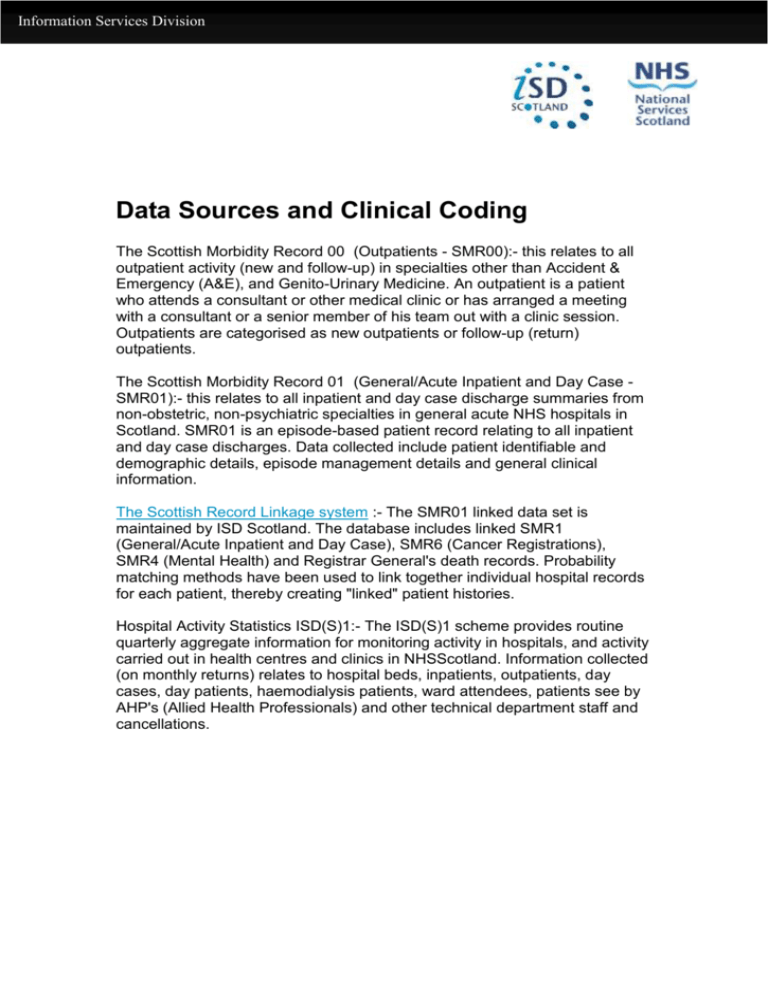
Information Services Division Data Sources and Clinical Coding The Scottish Morbidity Record 00 (Outpatients - SMR00):- this relates to all outpatient activity (new and follow-up) in specialties other than Accident & Emergency (A&E), and Genito-Urinary Medicine. An outpatient is a patient who attends a consultant or other medical clinic or has arranged a meeting with a consultant or a senior member of his team out with a clinic session. Outpatients are categorised as new outpatients or follow-up (return) outpatients. The Scottish Morbidity Record 01 (General/Acute Inpatient and Day Case SMR01):- this relates to all inpatient and day case discharge summaries from non-obstetric, non-psychiatric specialties in general acute NHS hospitals in Scotland. SMR01 is an episode-based patient record relating to all inpatient and day case discharges. Data collected include patient identifiable and demographic details, episode management details and general clinical information. The Scottish Record Linkage system :- The SMR01 linked data set is maintained by ISD Scotland. The database includes linked SMR1 (General/Acute Inpatient and Day Case), SMR6 (Cancer Registrations), SMR4 (Mental Health) and Registrar General's death records. Probability matching methods have been used to link together individual hospital records for each patient, thereby creating "linked" patient histories. Hospital Activity Statistics ISD(S)1:- The ISD(S)1 scheme provides routine quarterly aggregate information for monitoring activity in hospitals, and activity carried out in health centres and clinics in NHSScotland. Information collected (on monthly returns) relates to hospital beds, inpatients, outpatients, day cases, day patients, haemodialysis patients, ward attendees, patients see by AHP's (Allied Health Professionals) and other technical department staff and cancellations. Information Services Division Data Sources: The Scottish Morbidity Record 00 (Outpatients - SMR00) SMR00 relates to all outpatients (new and follow-up) in specialties other than Accident & Emergency (A&E), and Genito-Urinary Medicine. An outpatient is a patient who attends a consultant or other medical clinic or has an arranged meeting with a consultant or a senior member of his team outwith a clinic session. Outpatients are categorised as new outpatients or follow-up (return) outpatients. These are split into; New Outpatient - this is when a patient has a first meeting with a consultant or his representative following an outpatient referral. Follow-up (return) outpatient - this is when a patient has a second and subsequent attendances following the initial referral OR is there first and subsequent attendances following an inpatient/day case episode. Did not Attend - this is when the patient did not attend (DNA) and when the hospital is not notified in advance of the patient's unavailability to attend on the offered admission date, or for any appointment. SMR00 allows the recording of procedural information, for which a "Short list of Procedures performed on Outpatients" is available. The recording of this shortlist of procedures was mandatory, however many hospitals didn't record these procedures. As from 2003 it became mandatory that all procedures were recorded, again this remains inconsistent across NHS Boards. Outpatient data is available from 1991 onwards. Records are submitted on discharge. However, data is only readily available from April 1997 onwards. 2 Information Services Division Data Sources: The Scottish Morbidity Record 01 (General/Acute Inpatient and Day Case - SMR01) SMR01 is an episode-based patient record relating to all inpatients and day cases discharged from non-obstetric and non-psychiatric specialties. Geriatric long stay is also excluded (As from April 1997 onward Geriatric long stay started to be recorded on SMR50 - known as Geriatric Long Stay). Data collected include patient identifiable and demographic details, episode management details and general clinical information. Currently diagnoses are recorded using the ICD-10 classification and operations are recorded using the OPCS-4 classification. General acute admissions are categorised as follows; Inpatients - this is when a patient who occupies an available staffed bed in a hospital and: remains overnight whatever the original intention (except haemodialysis patients) OR - at admission, is expected to remain overnight but is discharged earlier (except haemodialysis patients). Discharges include transfers-out and deaths. Day Case - this is when a patient who makes a planned attendance to a specialty for clinical care, sees a doctor or dentist or nurse (as the consultants representative) and requires the use of a bed or trolley in lieu of a bed. The patient is not expected to, and does not, remain overnight. Many of these patients require anaesthesia. Inpatient admissions can be further broken down into; Emergency admission - this occurs when, for clinical reasons, a patient is admitted at the earliest possible time after seeing a doctor. The patient may or may not be admitted through Accident & Emergency. Coding rules state that a Day Case patient should not be admitted as an emergency. Elective (planned) admission - this is when the patient has already been given a date to come to hospital for some kind of procedure. Transfer - this is where a patient will already have been admitted to hospital and is either transferred between specialties or hospital, and will be part of the same continuous stay in hospital. ISD Scotland can provide a fuller explanation of the above if required. Data is readily available from 1981 onwards. However, information has been collected since 1961 although data from around 1965 onwards is considered to be more robust than previous years. Records are submitted on discharge. 3 Information Services Division Data Sources: Coding of Diagnostic and Procedural Information When a patient is admitted to hospital as an inpatient or day case within nonobstetric and non-psychiatric specialties, diagnostic and procedural information is recorded. At present this is recorded using; Diagnostic information:- this is currently recorded using the International Statistical Classification of Diseases and Related Health Problems, Tenth Revision (ICD10). Please also see below for changes in dates of recording practice. Procedural information: this is currently recorded using the Office of Population Censuses and Surveys, Classification of Surgical Operations and Procedures (OPCS4). Please also see below for changes in dates of recording practice. Read Codes (used mainly in a primary care setting). Changes in Coding Practice ICD ICD7 - from 1961 to 1967 ICD8 - from 1968 to 1979* ICD9 - from 1980 to March 1996 ICD10 - from April 1996 onward. * Please note that for ICD8 - during 1968 to 1974, 3 digit codes were recorded and 1975 to 1979, 4 digits were recorded. OPCS General Registrar's Office (GRO) - 1961 to 1970* OPCS2 - 1971 to 1976 OPCS3 - 1977 to 1988 OPCS4 - 1989 onward * Please note this could be classed as OPCS1, however, this was not nationally recognised as data as data was collected by the GRO. 4
